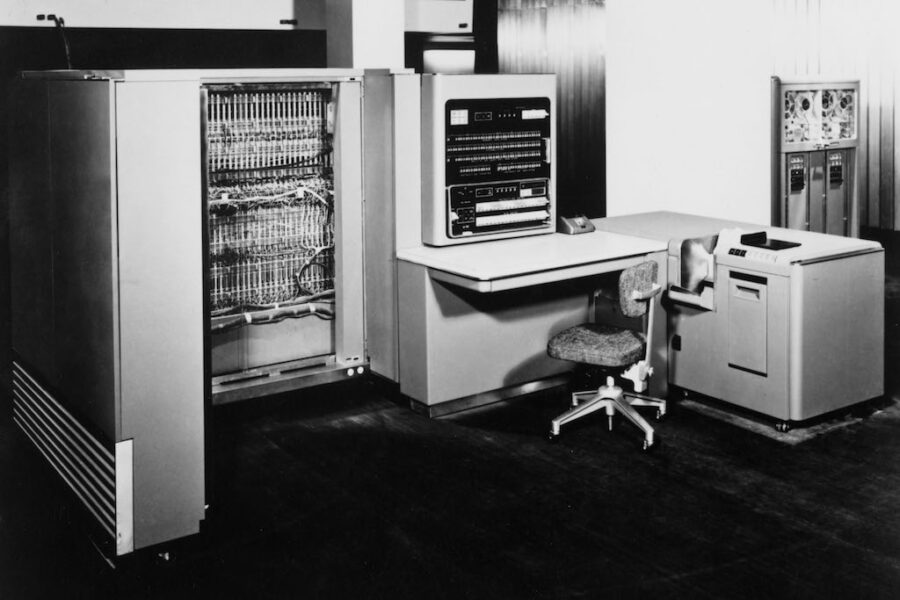Main image: The IBM 701 became the first digital computer that Rolls-Royce used in 1953 following research by Christopher L Johnson. Reprint Courtesy of IBM Corporation ©
The early 1950s heralded the dawn of commercial computing and the use of computers for business engineering and science. Organisations such as Lyons, Ford, Post Office and (what was to become) British Steel were applying computers to management. The Met Office, Rolls-Royce and researchers such as Prof (to be) Denis Noble were adopting early machines as the world began to embrace their performance capabilities for solving massive calculations.
In late 1952 Christopher L Johnson, a 37-year-old graduate engineer at Rolls-Royce, was commissioned to report on the value and feasibility of a “Proposed Computer Installation for the Design Department”.
A few months later, on 2 March 1953, the report was submitted and recommended that a computer should be acquired by Rolls-Royce and so began the engine-manufacturer’s position as a leader in the engineering and aviation application of computers in the UK.
Discovery of the Rolls-Royce document

Discovery of the original Rolls-Royce document was revealed in November 2022 when Archives of IT (AIT) interviewed Christopher’s son Tim Johnson, an eminent technology researcher, writer and publisher (founder of the market-leading Ovum) who found the report in his late father’s files. His father, who died in 1994, went on to become a hydraulics engineer for Rolls-Royce where he spent all his working life from 1938 to 1975.
The report gives a detailed account of the decision-making process of Christopher and his two colleagues as to whether Rolls-Royce should adopt the advances in computer technology to aid them in designing turbine blades.
“His main focus was hydraulics, for example for the jump-jet engine, but in 1952 he was commissioned by the management to report on the value and feasibility of a “Proposed Computer Installation for the Design Department,” says Tim.
The report highlights the technical anachronisms, the nuances of choosing a supplier, as well as references to the more prosaic office politics and how transformational the technology was calling it the first “electro-mechanical calculator” to speed up the processing of complicated numerical data. In fact, it seems spelling of the word computer itself was in its early stages as on the report’s cover page computer is typed out as computor and then the o at the end has been crossed out in pen and replaced by an e.
His father concluded that the calculation and printing ‘of [jet turbine] blade section profiles by a digital computer installation is a perfectly practical proposition’. He went on to point out that the ‘calculator’ could make an even greater contribution to Stress Office and Performance work and would raise both the ‘quantity and standard of work’ in all these fields.
The significance of choosing a supplier
Significantly, for the future of the industry, he also concluded that ‘I.B.M. is the only company operating in this country that can fully meet our requirements at the present time’ as it was the only potential supplier that could meet all requirements, standing out by being able to be programmed on-site using plug-in cards.
At the time of Christopher’s research, the IBM 701 Electronic Data Processing Machine, known as the Defense Calculator was in development and this was formally unveiled to the public in April 1953 as the IBM 701 Electronic Data Processing Machines – IBM’s first commercial scientific computer and its first series production mainframe computer.
The IBM 701 was the first computer in the IBM 700/7000 series, which were IBM’s high-end computers until the arrival of the IBM System/360 in 1964. Rolls-Royce were the one of the first companies outside the US to use the IBM computer and were among less than 20 in total that included the National Security Agency, Lockheed Aircraft Company and the General Electric Company.
Tim says the choice of supplier was between US firm IBM and the British firm, Powers-Samas (tabulating machine companies in 1911 and 1915 respectively) was also an important development in the history of computing. The Powers-Samas machines he says were similar in principle to the IBM but used control boxes made by Powers-Samas specifically for each job. “Clearly this would have been much slower and less convenient than the user-programmed option,” he says.
IBM also far outpaced Powers-Samas in their publication of programming manuals and technical papers on applications. The report reveals that the Rolls-Royce team also had the opportunity to meet a Dr Barnett, research fellow at London University, who was using the computer at IBM’s Service Bureau in London. They discussed the programming required for turbine blade design and Barnett offered to help with training. Again, IBM was well ahead of European firms in developing the intellectual structure needed to support computer applications.
Tim has calculated the costs on today’s money for the hire of the machine and its components:
“The rental for all the machines required would be £276 17s (Shillings) per month with a further initial £368 13s for extra equipment, mainly extra programming panels. In 2023 prices, the machines would be costing almost £10,000 (EUR11,320; US$12,110) a month and the extra equipment would be nearly £14,000 (EUR15,831; US$16,930).”
What’s in the report?
– Part IV of the Proposal discusses the application of a computer for ‘blade detailing’ – calculating the shape each blade needs to be for maximum efficiency.
– Part V considers its application to ‘Stress Office’ work – calculating the stress and vibration on different components of the engine – discs, plates and tubes for example. At present, the Proposal points out some problems simply cannot be solved ‘due to the prohibitive time that would be entailed’ (but could be calculated by computer). Instead actual sample parts have to be made and tested on a rig, causing considerable delay and expense. (Needs were to solve 30 or 40 simultaneous equations.)
– Part VI sets out the equipment required. The only illustration in the Proposal is an office plan for the Computer Section showing where the machines would go.
– Part VII sets out the ‘personnel required’ – three operators and a supervisor, who would need to have a maths degree and a ‘knowledge of modern vibration theory’.
– Part VIII sets out the financial case. It estimates six staff could be saved in the Blade Detailing office of whom three could move to the Computer Section. The other three could be transferred to the Tool Office to make use of the increased output generated by the computer. The computer would replace the work of four in the Stress Office and allow them to increase total output, in particular on work which is just too time-consuming at present. It estimates a 90% overall saving on time taken – a tenfold increase of productivity. It also lists four further areas where the computer could be used, such as aircraft performance estimates – ‘always required rapidly’.
Understanding the report
Tim is now working with AIT and Rolls-Royce to highlight the report’s significance and gain more insight into some unanswered questions.
“One mystery was who or what ‘Lom’ was – referred to several times in the report,” says Tim, who was former technology editor of The Sunday Times in the UK. “It turns out he was not a department but a person: Adrian Lombard, who had a stellar career in the design and production of world-leading jet engines, before dying of a brain haemorrhage in 1967, aged only 52. We should add sponsoring the early adoption of computers to his achievements.
“And also a striking feature of the report is its focus on the practical issues, from placating the accounts department, to the floor-plan of the computer section. The technical issues are more-or-less taken for granted.
“I remember my father said to me that the key technical issue for the report was whether the machine could do Fourier transforms at least as fast as three engineers with slide-rules. His key technical finding was, not only could it do that, it could also be programmed to do Laplace transforms. But there is no breath of that in the report.
“I expect there was another document somewhere which was about just what the programmes would look like – much more commercially valuable information I imagine.”
From mainframes to supercomputers and quantum
Tony Phipps, Chief of Future Methods and Professor Leigh Lapworth, a Rolls-Royce Fellow in Computational Science, have discussed the report with Tim. Tony says: “We’re focused on step-change technologies in our day job. While there are many incremental improvements to be had in the business, we’re only interested in transformational change and this first computer is the 1950s equivalent of that.
“The difference that computers made to design in those days was incredible, not necessarily in doing it quicker, but more providing insights of how we could design for better performance. Nowadays we’re still using ever increasing computing power to help us do that, but there is an efficiency and cost benefit by avoiding physical testing and instead using modelling.
“The next step is how we can go from spending perhaps months doing calculations on a classical supercomputer now, to how we could do the same calculations and much more in just a few hours with a quantum computer in the future.”
Rolls-Royce announced in February 2023 that it had partnered with Universal Quantum to scale quantum computers up to the level of whole engine simulations.
“There are still things we don’t and can’t yet model,” says Professor Lapworth. “To be able to pass quantum data from one module to another with only 0.000007% data loss is truly astounding and gives real hope that quantum computers will realise the promise they offer.”
The importance of the report
Christopher Johnson’s report offers an invaluable first-hand account of the early adoption of computing in engineering and AIT is privileged to have a pdf copy of the document in its collection.
This along with personal accounts such that of John Wallace – who in 1960 while working for the National Provincial Bank used a Ferranti Pegasus and then Orion to automate the UK’s first branch bank – allow us to recount the first instances of how computers have transformed our lives.
Through our articles and interviews with current scientists at the Met Office, an organisation that first had meetings about using computers in 1948 and began using a Leo computer in 1952, we can also see, just as in the case of Rolls-Royce, how they have become one of the most demanding users of processing power, which has led to their extensive use of supercomputers.
If you have any information on Rolls-Royce’s early use of computers or have anything to add the report, then please email us at: research@archivesit.org.uk.
